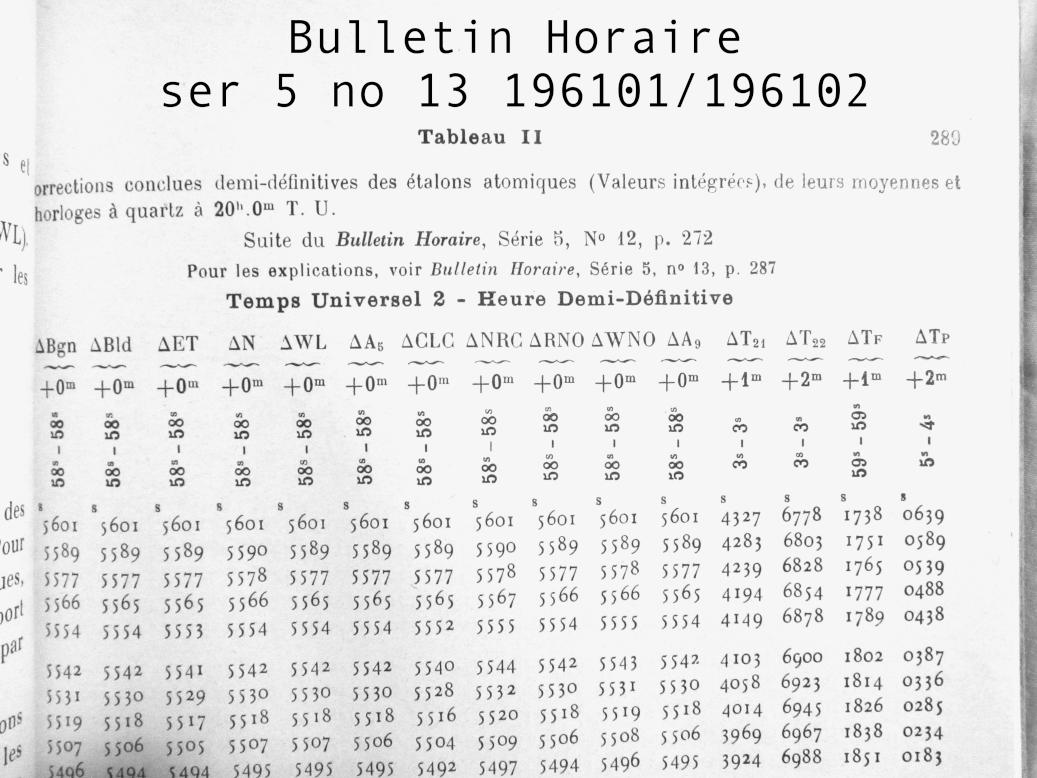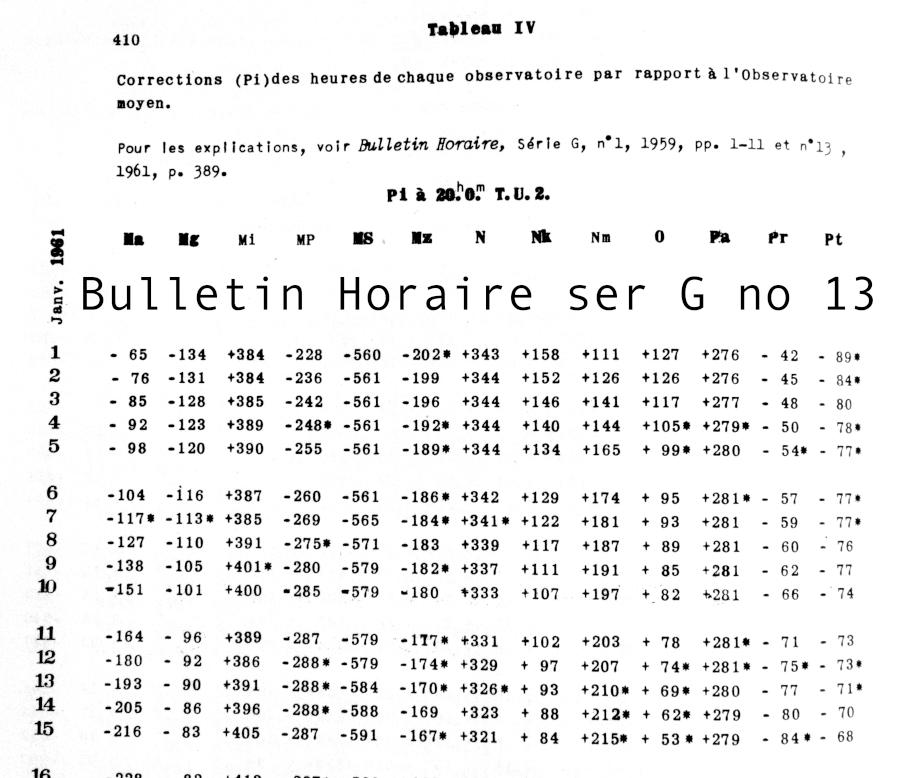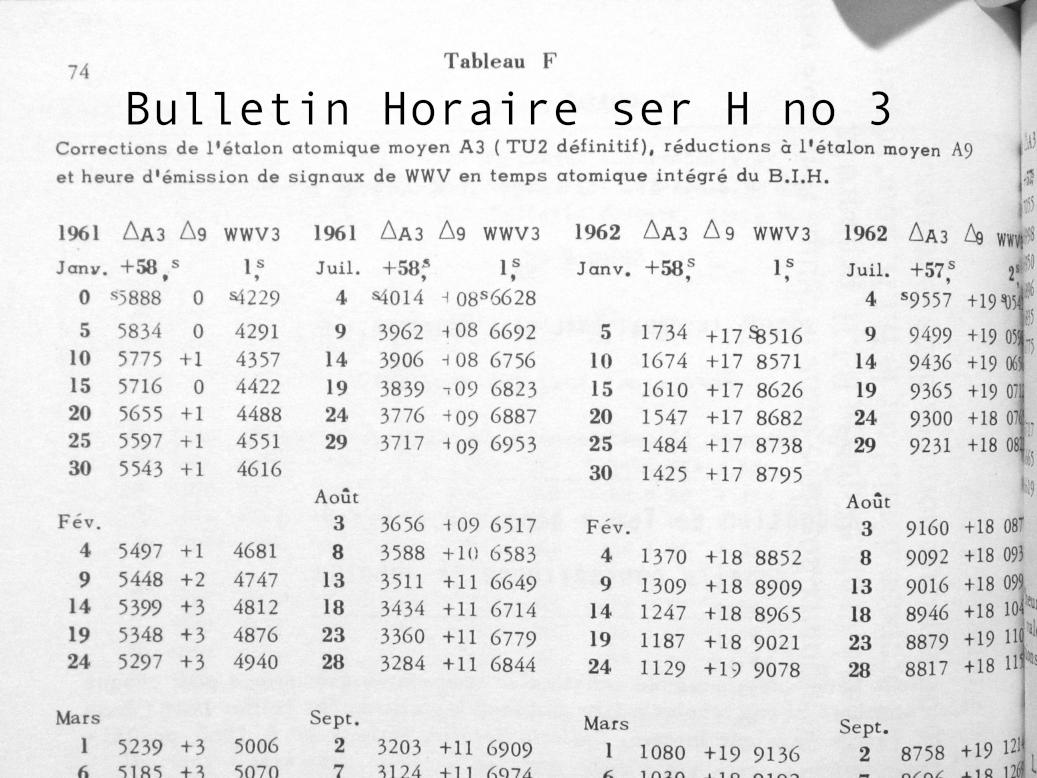After several individual laboratories with cesium atomic chronometers started constructing atomic time scales the CCDS meeting in 1961 suggested that BIH should construct an international version. BIH complied and produced tables of Temps Atomique Integre based on all of the available atomic chronometers.
The USNO atomic time scale was called A.1 and its value had been set equal to UT2(Washington) as of 1958-01-01. The initial BIH atomic time scale was based on as many atomic chronometers as were available starting in 1955, and by 1958 there were 5, so BIH named their time scale A5. BIH followed the lead of USNO and set their atomic time scale A5 equal to UT2(BIH) as of 1958-01-01T20:00:00.
The second CCDS meeting happened 1961-04-11/12. Recommendation 2 of that meeting authorized BIH to publish their atomic time scales.
By 1961 there were 9 cesium atomic chronometers available for
comparison.
BIH created another time scale A9 based on all of those.
While creating A9 BIH reset the values of their time scales for all 9
chronometers.
For 1961-01-01T20:00:00 UT2(OP) we see (UT2 - Heure
demi-definitiveParis(AllBIHatomics)) = (60 - 58.5601) =
-1.4399 s
As reference with the tables below also note that
For 1961-01-05T20:00:00 UT2(OP) we see (UT2 - Heure
demi-definitiveParis(A9)) = (60 - 58.5554) = -1.4446
For 1961-01-10T20:00:00 UT2(OP) we see (UT2 - Heure
demi-definitiveParis(A9)) = (60 - 58.5495) = -1.4505

In mid 1962 BIH had received and computed the data from
all the observatories in 1961, and they published their
values of Pi.
This allowed BIH to convert the epoch of all the atomic time
scales from Heure demi-definitiveParis to
Heure definitive.
At 1961-01-01T20:00:00 UT2(BIH) we see PParis = +0.0276 s
Heure definitive = Heure demi-definitiveParis + PParis
For 1961-01-01T20:00:00 UT2(BIH) we have Heure definitive(AllBIHatomics) = -1.4399 + 0.0276 = -1.4123 s
As reference with the table below also note that
At 1961-01-05T20:00:00 UT2(BIH) we see PParis = +0.0280 s
At 1961-01-10T20:00:00 UT2(BIH) we see PParis = +0.0281 s

By 1964 BIH realized that some atomic chronometers were much better
than others, and they constructed A3 based on the best 3.
BIH set A3 equal to A5 and A9 at the epoch when they were synchronized.
This put (UT2 - Heure definitive(AllBIHatomics)) = -1.4123 s at
the epoch 1961-01-01T20:00:00 UT2(BIH).
In the process of tabulating A3 they re-interpolated all the data
for 5 day intervals at UT2 = 20:00:00
Heure definitive(A3) = Heure demi-definitiveParis(A9) - 𝝙9 + PParis
For 1961-01-05T20:00:00 UT2 we see (60 - 58.5834) = -1.4166 = -1.4446 - 0.0000 + 0.0280
For 1961-01-10T20:00:00 UT2 we see (60 - 58.5775) = -1.4225 = -1.4505 - 0.0001 + 0.0281
So although 1961-01-01 is missing in the following table we can see
that A3 matches A9 in the days immediately following.

After Anna and Nicholas Stoyko retired from BIH
Bernard Guinot reinterpolated A3 from 20h UT2 to 0h UT2.
Subsequently BIH changed A3 to become a weighted average
of the best available cesium atomic chronometers.
In 1971 when the CGPM approved the creation of TAI it was based on A3.
At the epoch 1961-01-01T20:00:00 UT2(BIH) the Heure definitive offset
currently recognized as UT2(BIH) - A3 = -1.4123 s
So the offset between Universal Time and the TAI that we now have was
not set at 1958-01-01 because all BIH atomic time scales were reset to
this same fixed offset at 1961-01-01T20:00:00 UT2(OP).
More details coming soon:
In the above table there is a jump of 1.6 ms on 1962-01-01 because
that is the date of the switch from the FK3 catalog to the FK4
catalog.
So the value of A3 at epoch 1961-01-01T20:00:00 UT2(OP) does not
correspond to values of UT2 that would have been quoted a year or more
later.
Unanswered question:
When Guinot re-interpolated A3 from 20h UT2 to 0h UT2 did
he compensate for the 1.6 ms discontinuity at 1962-01-02?
Also, in the glimpse of the table above note that 𝝙9 increases notably. This is saying that the rates of A9 and A3 differed notably. That rate difference was eventually recognized as a problem and it is why the rate of TAI was changed by 1e-12 on 1977-01-01.